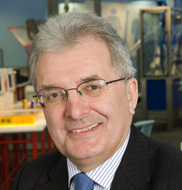

Professor Chris Rapley CBE has been the Director of the Science Museum since 2007. He was Director of the British Antarctic Survey for ten years, between 1998 and 2007. During his time in the Antarctic, he helped Al Gore with the "Live Earth" concert by arranging for the Rothera Research Station's in-house band, Nunatak, to perform in Antarctica as part of the event. Prior to this appointment, he was Executive Director of the International Geosphere-Biosphere Programme at the Royal Swedish Academy of Sciences, Stockholm, and before that, Professor of Remote Sensing Science and Associate Director of UCL’s Mullard Space Science Laboratory. Between 1975 and 1981, Rapley was a scientist on NASA's Solar Maximum Mission; he was a lecturer at the Department of Space and Climate Physics of University College London from 1981 to 1987.
Rapley was educated at King Edward's School, Bath, Jesus College, Oxford (obtaining a BA in Physics in 1969), at Manchester University (obtaining a MSc in Radio Astronomy in 1976) and University College London (obtaining a PhD in X-ray Astronomy in 1976).
In 2008 he was awarded the Edinburgh Science Medal – “For professional achievements judged to have made a significant contribution to the understanding and well-being of humanity”, particularly for his work on climate and climate change. This is a prestigious award given each year to men and women of science and technology whose professional achievements are judged to have made a significant contribution to the understanding and well-being of humanity. He is a Fellow of St Edmund’s College, Cambridge, an Honorary Professor at University College London and University of East Anglia, and a Distinguished Visiting Scientist at NASA’s Jet Propulsion Laboratory. He has also been awarded the CBE.
About this lecture
The talk will address the relationship between human energy use and climate change, and the pressing need to maintain our energy supplies whilst stabilising or reducing greenhouse gas concentrations in the atmosphere. It will explore the technical and social options available to deal with the problem, progress to date, the outcome of the Copenhagen negotiations, and the range of possible futures that lie ahead.